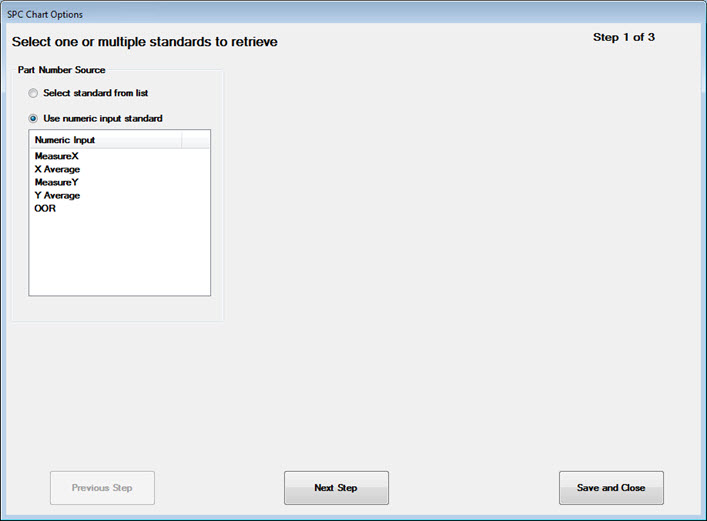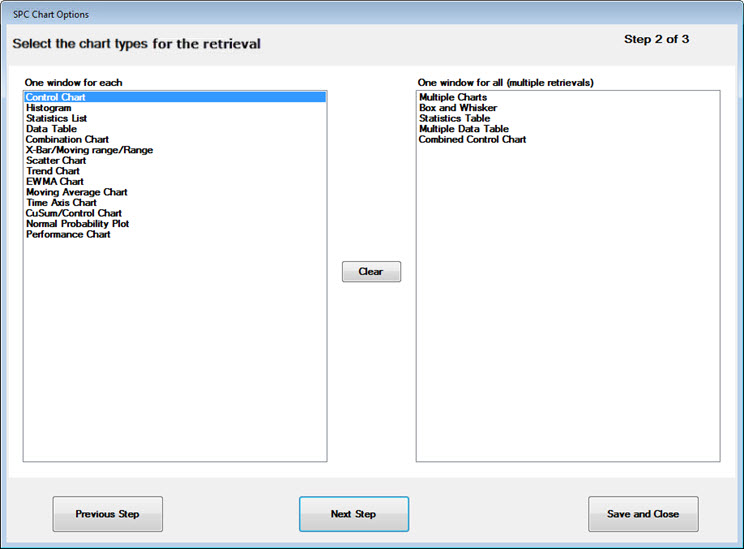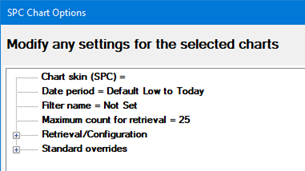SPC Chart Options
The SPC Chart Options window
lets you configure charts to display on the current sub-inspection. For
information on opening this window, see Setting
charts to display in inspections.
Step
1: Select SPC standards for the retrieval
If you want this sub-inspection to chart
multiple standards with the same chart types and chart settings (date
period, filter, statistical settings, etc.), you can use this step to
select all those standards at once –
beginning with the Part Number Source:
Select standard from list:
Use this option to select any standard(s) for data entry charts
– regardless
of any Numeric Input tests in the inspection. For more information,
see Selecting
Part Numbers or Processes.
Use numeric input standard:
Use this option to select the Numeric
Input test(s) in this sub-inspection as the source for your
standard. Click the Numeric Input test name(s) to chart for this
sub-inspection.
 Note: If you copy and paste
a sub-inspection that is configured to chart one or more numeric
input standards, you will need to re-select the standards for
these charts in the new copy of the sub-inspection. This is because
the numeric input tests in the new sub-inspection will have different
TestIDs from those in the original sub-inspection. A reminder
message will be displayed when you copy and paste such a sub-inspection. Note: If you copy and paste
a sub-inspection that is configured to chart one or more numeric
input standards, you will need to re-select the standards for
these charts in the new copy of the sub-inspection. This is because
the numeric input tests in the new sub-inspection will have different
TestIDs from those in the original sub-inspection. A reminder
message will be displayed when you copy and paste such a sub-inspection.
|
When finished selecting standards, click
Next Step.

Step
2: Select chart types
Select
the SPC chart types you want to display, and then click Next
Step.

Step 3: Modify settings for the selected charts

Choose
retrieval and statistical settings for the standards and charts you
have selected. You can also specify a Chart
skin (created in the GainSeeker Charts module) that changes display
options for these charts. When finished, click Save
and Close.
 Tip: If desired, you can configure
the charts with a special filter for data that matches traceability values
in this inspection:
Tip: If desired, you can configure
the charts with a special filter for data that matches traceability values
in this inspection:
Filtering for inspection traceability values
In some cases, you may wish to filter the
chart for a traceability value that was entered in this inspection – by a Traceability
test, Planned Inspection, or
Formula test (using inspect.cursubi.trace(idx).value or
inspect.settracevalue
Python commands).
For example, you might
wish to filter for:
To filter for such a traceability
value – which may
vary from one data entry session to the next –
you must create
a saved filter that looks for a blank value in that traceability field,
such as this example which filters for the current Cavity number:

 Best practice: For this type of
traceability filter, best practice is to set this traceability value before launching the sub-inspection
that filters charts for that value. This is most easily accomplished by:
Best practice: For this type of
traceability filter, best practice is to set this traceability value before launching the sub-inspection
that filters charts for that value. This is most easily accomplished by:
requiring
the user to Submit the traceability value in a Traceability
test on a previous sub-inspection
removing this traceability field from the inspection
and using a Planned Inspection
to set the traceability value
removing
this traceability field from the inspection and using a Formula test to set the
traceability value with the Python command inspect.settracevalue.
(You can actually execute this Formula on the same sub-inspection
as the filtered charts by setting the FormulaMode
property to Pre.)
The reason for this recommended
practice is that the filter can only access a traceability value after that value has been submitted.
If the traceability value
is not set before the sub-inspection with the filter is launched, the
charts will be filtered for a blank value in this traceability field until
the sub-inspection is submitted with the new traceability value.
When new charts are
opened and updated during an inspection
When you use the ChartOptionsSPC
property of a sub-inspection to set up charts, the timing for creating
and updating those charts depends on how the standard for those charts
is defined.
 Note: When the inspector submits
the sub-inspection data, all charts open in the right side panel refresh
for that sub-inspection. If you have multiple charts or charts containing
a lot of data open in the panel, this could prove time consuming.
Note: When the inspector submits
the sub-inspection data, all charts open in the right side panel refresh
for that sub-inspection. If you have multiple charts or charts containing
a lot of data open in the panel, this could prove time consuming.
Preset SPC standards
When a standard is selected using one
of these methods, the corresponding chart will be created immediately
when the sub-inspection opens:
When setting the sub-inspection
property ChartOptionsSPC,
the Part Number Source
is set to Select standard
from list
When setting the sub-inspection
property ChartOptionsSPC,
the Part Number Source
is set to Use numeric input
standard, and the selected Numeric
Input test meets one
of the following criteria:
The Numeric Input test has the SPCStandardSelection
property set to PickAheadOfTime
and the SingleSPCStandard
property set to a particular standard
 Please note: If the SingleSPCStandard
property contains a value that does not match an existing
SPC standard, the inspection will still create a chart
with no data found for that standard
Please note: If the SingleSPCStandard
property contains a value that does not match an existing
SPC standard, the inspection will still create a chart
with no data found for that standard
A Planned Inspection
is used to select a different standard for the Numeric
Input test
The sub-inspection also contains a Formula
test with the FormulaMode
property set to Pre
and the PythonScript
property set to a script that uses the inspect.cursubi.ni(idx).partno
command to set a different standard
When the user submits the sub-inspection,
these charts will be updated to include the most recently-entered data.
SPC standards selected by the data entry
user:
When all
of the following criteria are met, the chart for a standard will be created
immediately after the data entry user selects the standard:
When setting the sub-inspection property ChartOptionsSPC,
the Part Number Source
is set to Use numeric input
standard
The Numeric Input test you select to be charted has
the SPCStandardSelection
property set to PickAtRuntime
If the user later selects a different standard
for the same Numeric Input test, a new chart will be added for the new
standard without removing the chart for the previous standard.
When the user submits the sub-inspection,
these charts will be updated to include the most recently-entered data.
When charts are closed during an inspection
Any of the following methods will close all
charts that are currently open in an inspection:
To close all charts when a sub-inspection
opens, set the sub-inspection property ClearSidePanel
to True
To close all charts when a Python
script finishes running, add the Python command inspect.cursubi.clearsidepanel
= True to your script
Close the inspection
 Please note: Closing a sub-inspection
does not close the charts that are currently open.
Please note: Closing a sub-inspection
does not close the charts that are currently open.
Sending emails with charts during an inspection
 Note: If you copy and paste
a sub-inspection that is configured to chart one or more numeric
input standards, you will need to re-select the standards for
these charts in the new copy of the sub-inspection. This is because
the numeric input tests in the new sub-inspection will have different
TestIDs from those in the original sub-inspection. A reminder
message will be displayed when you copy and paste such a sub-inspection.
Note: If you copy and paste
a sub-inspection that is configured to chart one or more numeric
input standards, you will need to re-select the standards for
these charts in the new copy of the sub-inspection. This is because
the numeric input tests in the new sub-inspection will have different
TestIDs from those in the original sub-inspection. A reminder
message will be displayed when you copy and paste such a sub-inspection.


